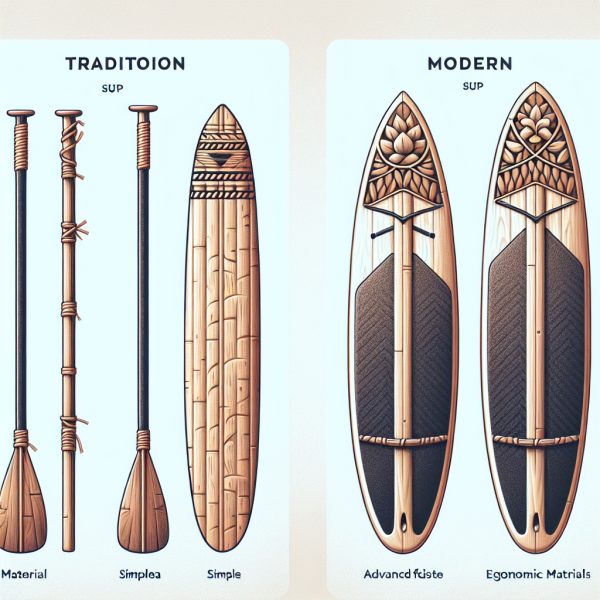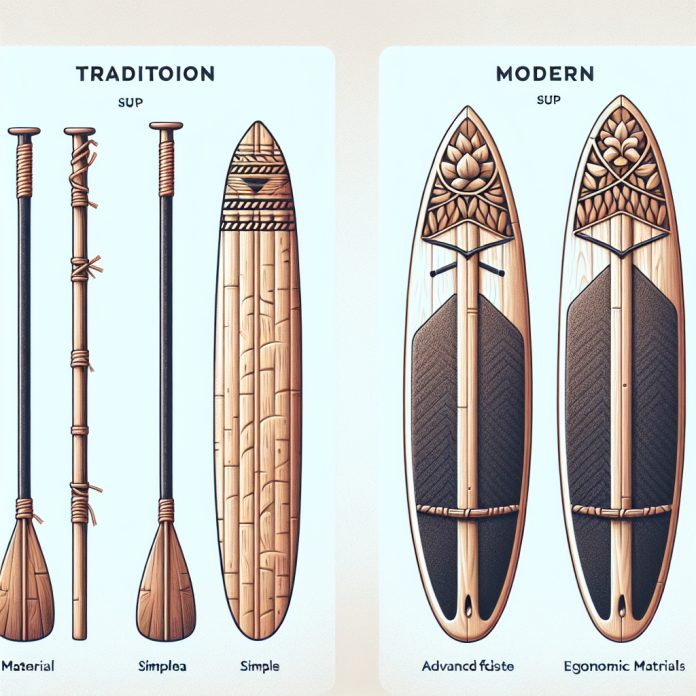In the realm of stand-up paddleboarding (SUP), the evolution of paddle designs has revolutionized the sport. However, amidst the array of contemporary innovations, it is essential to acknowledge the roots that laid the foundation for this popular water activity. The traditional Hawaiian SUP paddle, with its unique construction and distinct characteristics, sets itself apart from its modern counterparts. Join us as we embark on a fascinating journey through time to uncover the distinguishing features that made the traditional Hawaiian SUP paddle different from the designs we see today.

Materials
Wood
Wood has been a staple material in paddle construction for many years, dating back to the traditional Hawaiian SUP paddle. In traditional designs, wood, such as koa, was often the primary material used for crafting these paddles. Wood offers a natural, rustic aesthetic and provides a smooth feel in the water. It is also known for its durability, making it an excellent choice for those who seek a long-lasting paddle.
Fiberglass
In modern design, fiberglass has gained popularity as a material choice for SUP paddles. This versatile material offers advantages such as being lightweight, strong, and resistant to water damage. Fiberglass paddles allow for efficient paddling due to their high stiffness, enabling paddlers to generate more power with each stroke. Additionally, fiberglass paddles often feature vibrant colors and a sleek finish, adding a contemporary touch to the paddling experience.
Carbon Fiber
Carbon fiber is a cutting-edge material revolutionizing the SUP paddle industry. Known for its exceptional strength-to-weight ratio, carbon fiber paddles are incredibly lightweight and incredibly rigid. This rigidity allows for maximum transfer of power from the paddler to the water, resulting in a more efficient and effective paddle stroke. With their advanced technology and sleek appearance, carbon fiber paddles have become a top choice for performance-oriented paddlers.
Design
Shape
The shape of a paddle greatly affects its performance and efficiency in the water. Traditional Hawaiian SUP paddles typically featured broad, rounded blade shapes with gentle curves. This design allowed for a smooth and efficient stroke, providing ample power without excessive strain on the arms and shoulders.
Modern designs, on the other hand, have introduced variations in shape to cater to different paddling styles and conditions. Some modern paddle shapes feature more pronounced scoops or dihedral angles, which enhance stability and reduce flutter during the stroke. These design modifications aim to optimize performance for various paddleboarding disciplines, such as touring, racing, or surfing.
Length
The length of a paddle is crucial in achieving an effective and comfortable paddling experience. Traditional Hawaiian paddles were generally shorter, as they were primarily used for standing paddling in calm coastal waters or leisurely exploration of inland waterways. The length was often customized to the individual’s height, ensuring a proper paddle stroke and minimizing strain on the body.
Modern designs cater to diverse paddling styles and environments, offering adjustable length options to accommodate different water conditions and activities. Adjustable paddles allow users to adapt the length based on their preferences and specific paddling needs, such as navigating rough seas or engaging in high-intensity racing.
Blade Size and Shape
Blade size and shape play a significant role in paddle efficiency, maneuverability, and overall performance. Traditional Hawaiian SUP paddles typically featured wider blades with a gentle taper, allowing for increased power and stability. These broader blades offered the advantage of a larger surface area, enabling the paddler to move more water with each stroke.
Modern paddle designs often provide options for blade size, catering to diverse paddling preferences. Some paddles feature narrower blades with a more pronounced taper, which allows for quick and agile maneuvers. Others offer larger surface areas for enhanced power and stability during longer paddling sessions or in challenging water conditions.
Handle Design
The handle design is a critical aspect of paddle comfort and control. Traditional Hawaiian paddle handles were often simple and ergonomic, featuring a rounded shape that fit comfortably in the palm of the hand. These handles provided a secure grip and allowed for fluid movement through the water.
Modern paddle handles have evolved to offer enhanced ergonomics and versatility. Some designs incorporate ergonomic contours and padding to reduce hand fatigue and provide a more natural grip. Additionally, some modern paddles feature adjustable handles that allow paddlers to customize the angle, providing optimal comfort and control based on their individual preferences.
Weight
The weight of a paddle can significantly impact a paddler’s experience on the water. Traditional Hawaiian SUP paddles, crafted primarily from wood, tend to be heavier compared to modern designs. While the weight may provide a sense of durability, it can also lead to increased fatigue and potential strain on the arms and shoulders during longer paddling sessions.
Modern materials such as fiberglass and carbon fiber have introduced lightweight alternatives, offering paddles that are lighter, without compromising strength and durability. This reduction in weight allows paddlers to maintain a more efficient stroke and prolong their time on the water without excessive fatigue.
Flexibility
Flexibility is a crucial factor in paddle performance, affecting power transfer and paddle feel. Traditional Hawaiian paddles, made from solid wood, generally had minimal flexibility. This stiffness provided a sturdy and predictable stroke, allowing paddlers to exert consistent power throughout each stroke.
Modern paddle designs often incorporate materials that provide varying degrees of flexibility. Fiberglass paddles typically offer a balance between stiffness and flex, providing a responsive paddle stroke while still absorbing some of the shock and strain on the body. On the other hand, carbon fiber paddles are known for their high rigidity, offering minimal flex for maximum power transfer and efficiency.
Grip
Traditional Hawaiian Grip
The traditional Hawaiian grip exemplifies simplicity and efficiency. It typically involved holding the paddle with both hands placed close together, roughly shoulder-width apart. One hand gripped the paddle shaft near the blade, while the other hand held the shaft near the center. This grip allowed for a firm hold and provided control over the paddle, ensuring precise movements through the water.
Modern Grip Designs
Modern paddle designs have introduced various grip options that cater to individual paddling styles and preferences. Some modern paddles feature T-shaped grips, providing a more ergonomic and comfortable hand position. This design allows paddlers to maintain a relaxed grip, reducing hand fatigue and promoting overall paddle control.
Other paddle grips incorporate advanced materials, such as foam or rubber, to enhance comfort and reduce slippage. These materials provide a cushioned and non-slip surface, allowing for a secure grip even when wet. With the advancement in grip design, paddlers can now choose the grip that best suits their needs for comfort and control.
Cost
The cost of a SUP paddle can vary depending on factors such as materials, construction process, and brand. Traditional Hawaiian SUP paddles, often handcrafted from wood, can be comparatively more expensive due to the intricate craftsmanship involved and the rarity of high-quality wood materials.
Modern paddle designs offer a range of price points to cater to different budgets and preferences. Paddles made with fiberglass or carbon fiber tend to be more expensive due to the technological advancements and advanced materials utilized. However, there are also affordable options available that provide excellent performance and durability, making SUP paddling accessible to a broader range of enthusiasts.
Production Process
Traditional Hawaiian Production Process
Traditional Hawaiian SUP paddles were crafted through a labor-intensive process that involved hand-selecting and shaping the wood. Skilled craftsmen meticulously carved the desired shape, ensuring proper weight distribution and balance. The paddle was then carefully sanded, often by hand, to achieve a smooth finish. Finally, the paddle was treated with oils or varnishes to enhance its longevity and protect it from the elements.
Modern Production Process
Modern production processes have introduced advanced manufacturing techniques and materials, streamlining the paddle production process. Modern paddle construction often involves precision molding and computer-aided design to create consistent shapes and dimensions. Materials such as fiberglass or carbon fiber are then layered and bonded, creating a strong and lightweight paddle. This streamlined process allows for mass production, making modern SUP paddles more readily available and accessible to a wider audience.
Historical Significance
The traditional Hawaiian SUP paddle holds significant historical and cultural value. Paddling has been a fundamental part of Hawaiian culture for centuries, used primarily for transportation, fishing, and recreational purposes. Traditional Hawaiian paddles embody the island’s rich history and serve as a cultural symbol, reflecting the connection between the Hawaiian people and their surrounding waters.
Historically, paddling played a vital role in Hawaiian society, with various paddle sports and competitions being held to showcase strength, skill, and endurance. These events fostered community participation and celebrated the intrinsic bond between the people and the ocean. As modern paddleboarding gained popularity, the traditional Hawaiian SUP paddle’s historical significance remains a testament to the roots and heritage of paddle sports in Hawaii.
Performance
Performance is a key consideration for both traditional and modern SUP paddles. Traditional Hawaiian paddles, with their solid wood construction and time-tested designs, offer stability, reliability, and a familiar feel. Their broad blades provide excellent power and control, making them ideal for leisurely paddling or exploring calm coastal waters.
Modern paddle designs focus on maximizing performance through advanced materials and innovative shapes. Fiberglass and carbon fiber paddles offer exceptional stiffness, translating to efficient power transfer and enhanced stroke efficiency. These designs cater to various paddling disciplines, allowing paddlers to excel in racing, surfing, touring, or fitness paddling, depending on their preferences.
Usage
Traditional Hawaiian Usage
Traditional Hawaiian SUP paddles were primarily utilized for standing paddling or sitting while navigating calm coastal waters. These paddles were versatile and well-suited to fishing, transportation, leisurely exploration, and cultural ceremonies. The traditional usage reflected the Hawaiian people’s deep connection to the ocean and their reliance on paddling as a means of sustenance, transportation, and leisure.
Modern Usage
Modern paddleboarding has expanded the usage of SUP paddles, opening up a world of possibilities for enthusiasts. With the advancements in design and materials, paddlers can now engage in various activities such as racing, fitness paddling, surfing, and touring. Paddles are designed to cater to specific disciplines, offering features that optimize performance based on the paddler’s chosen activity. This versatility allows individuals to explore different water conditions and territories, embracing SUP paddling as an enjoyable recreational pursuit or a competitive sport.
In conclusion, the traditional Hawaiian SUP paddle laid the foundation for modern designs, incorporating time-tested craftsmanship, durability, and cultural significance. However, with advancements in materials, design, and manufacturing processes, modern paddles now offer enhanced performance, versatility, and customization. From the choice of materials to blade size and shape, handle design, and even grip options, modern paddles provide a range of features to suit the preferences and needs of individual paddlers. Whether embracing the rich history of the traditional Hawaiian paddle or embracing the cutting-edge technology of modern designs, both types offer an exhilarating and rewarding experience on the water.





































